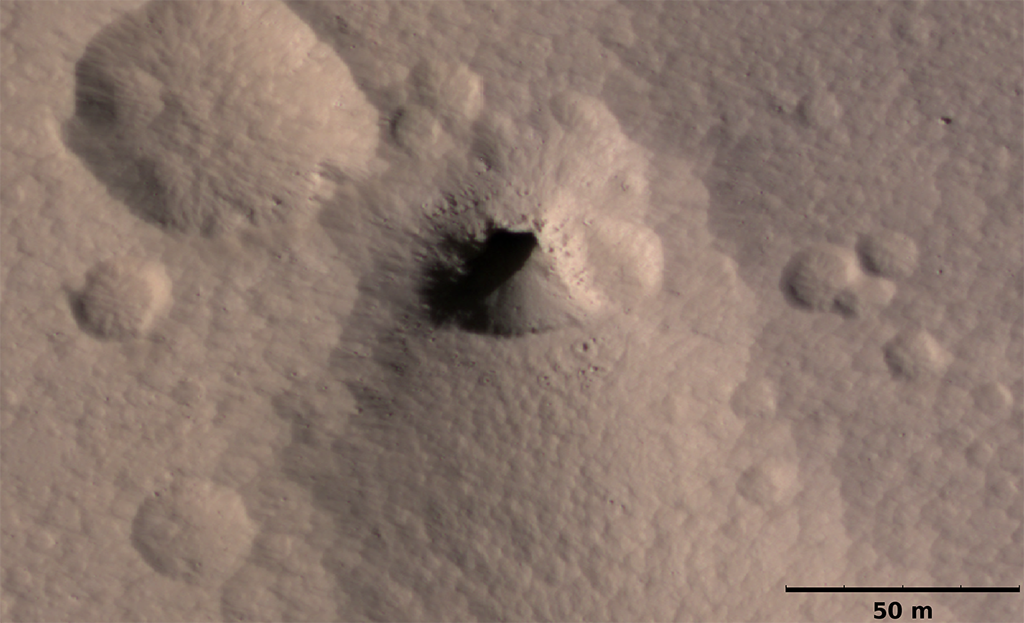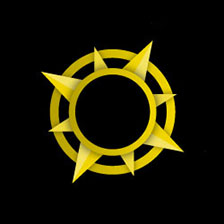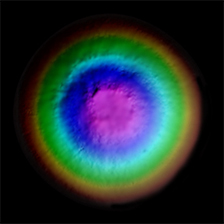Mars Global Cave Candidate Catalog v1 Cushing
- Primary Authors
- Glen Cushing
- Originators
- USGS Astrogeology Science Center
- Publisher
- USGS Astrogeology Science Center
- Publication Date
- 2017-06-01
- Abstract
- Product Information: The Mars Global Cave Candidate Catalog (MGC^3) contains the locations of known candidate cave-entrances Mars. Most entries in this catalog were identified through surveys of images from the Mars Reconnaissance Orbiterâs (MRO) Context Camera (CTX) and High Resolution Imaging Science Experiment (HiRISE) cameras. CTX images show the Martian surface in visible (red) wavelengths at a scale of ~6 meters per pixel (m; Malin et al., 2007), which is sufficient to identify sky-facing, shadowed cave entrance candidates as small as ~25 m across. Many of the highest quality candidates identified in the CTX survey were subsequently targeted HiRISE, which also observes at scales as fine as ~0.25 m/pixel (McEwen et al., 2007), which is ~1/500 of a single CTX pixel. This ultrafine resolution achieved by HiRISE is useful to determine which candidates (of those identified in CTX images) show evidence that subsurface cavities may extend beyond the observed line of sight (e.g., overhanging rims, surface skylights, etc.); this resolution also provides sufficient detail to characterize fine-scale surface features in and around the entrances such as aeolian bedforms, cliff-wall strata and dust/bedrock interfaces. This dataset is being archived in the Planetary Data System (PDS) for use in future planetary cave research. Future contributions of new candidate entrances, the addition of thumbnail images, and refinements to existing measurements will drive subsequent versions of this dataset. NOTE: Because the candidates listed here have only been observed from Mars orbit, NONE can be verified as âgenuineâ caves with void spaces extending into dark zones beneath the surfaceâsuch verification is not possible until they are physically visited. Historically, the larger portion of candidates identified in CTX images have proven to be false positives (see Targeting Priority, below), revealed by HiRISE to be simple pits, depressions, or hard shadows instead of viable cave-entrance candidates. This archive uses PDS4 archiving standards. An overview of PDS4 is provided in the PDS4 Concepts document (2018) and the standards are specified in the PDS4 Standards Reference (2018). Mission and Instrument Information: NASA's Mars Reconnaissance Orbiter (MRO), launched August 12, 2005, is on a search for evidence that water persisted on the surface of Mars for a long period of time. While other Mars missions have shown that water flowed across the surface in Mars' history, it remains a mystery whether water was ever around long enough to provide a habitat for life. MRO successfully arrived at Mars on March 10, 2006. The mission has shown unprecedented detail in orbital images of Mars. The Context Camera (CTX) is currently orbiting Mars and acquiring grayscale (black & white) images at 6 meters per pixel scale over a swath 30 kilometers wide. CTX provides context images for HiRISE and CRISM, is used to monitor changes occurring on the planet, acquires stereo pairs of select critical science targets. CTX data sets are produced by the CTX Team at Malin Space Science Systems, San Diego, USA. The Hi Resolution Imaging Science Experiment (HiRISE camera) is a pushbroom imaging system featuring a 0.5 m aperture telescope with a 12 m focal effective length and 14 CCD detectors capable of generating images of up to 20,000 cross-scan observation pixels and 65,000 unbinned scan lines. The HiRISE instrument capabilities include the acquisition of observations of the Mars surface from orbit with a ground sampling dimension between 25 and 32 cm/pixel. HiRISE data sets are produced by the HiRISE Team at the University of Arizona Lunar and Planetary Laboratory, Tucson, Arizona, USA (PDS IMG, 2018b). 2001 Mars Odyssey is part of NASA's Mars Exploration Program, a long-term effort of robotic exploration of the red planet. The opportunity to go to Mars comes around every 26 months, when the alignment of Earth and Mars in their orbits around the sun allows spacecraft to travel between the two planets with the least amount of energy. 2001 Mars Odyssey launched on April 7, 2001, and arrived at Mars on October 24, 2001. The 2001 Mars Odyssey carries three star cameras, the Mars Radiation Environment Experiment (MARIE), which measures the near-space radiation environment as related to the radiation-related risk to human explorers, the Thermal Emission Imaging System (THEMIS), which maps the mineralogy of the martian surface using a high-resolution camera and a thermal infrared imaging spectrometer, and the Gamma-Ray Spectrometer (GRS), which maps the elemental composition of the surface and determine the abundance of hydrogen in the shallow subsurface (PDS IMG, 2018a). The part of the THEMIS imaging system that takes pictures in visible light is able to show objects about as big as a semi-truck. This resolution helps fill in the gap between large-scale geological images from the Viking orbiters in the 1970s and the very high-resolution images from the currently orbiting Mars Global Surveyor (NASA, 2019). References: Malin, M. C., Bell III, J. F., Cantor, B. A., Caplinger, M. A., Calvin, W. M., Clancy, R. T., Edgett, K. S., et al. (2007). Context Camera Investigation on board the Mars Reconnaissance Orbiter. Journal of Geophysical Research: Planets, 112(E5). https://doi.org/10.1029/2006JE002808 McEwen, A. S., Eliason, E. M., Bergstrom, J. W., Bridges, N. T., Hansen, C. J., Delamere, W. A., Grant, J. A., et al. (2007). Mars Reconnaissance Orbiter's High Resolution Imaging Science Experiment (HiRISE). Journal of Geophysical Research: Planets, 112(E5). https://doi.org/10.1029/2005JE002605 National Aeronautics and Space Administration (NASA) (2019). Mars Odyssey. THEMIS. https://mars.jpl.nasa.gov/odyssey/mission/instruments/themis/ Planetary Data Systems (PDS) Cartography and Imaging Sciences (IMG) (2018a). 2001 Mars Odyssey. https://pds-imaging.jpl.nasa.gov/portal/odyssey_mission.html Planetary Data Systems (PDS) Cartography and Imaging Sciences (IMG) (2018b). Mars Reconnaissance Orbiter (MRO). https://pds-imaging.jpl.nasa.gov/portal/mro_mission.html Recommended Citation: G. E. Cushing. (2015). Mars Global Cave Candidate Catalog PDS4 Archive Bundle. PDS Cartography and Imaging Sciences Node (IMG). https://doi.org/10.17189/1519222
- Purpose
- Created as part of a project funded by NASA's Mars Data Analysis Program (MDAP), the purpose of this catalog is to provide locations of known candidate cave-entrance locations on Mars.
Contact and Distribution
- Format
- Database, Spreadsheet, Tabular Data
- Access Scope
- Astrogeology, Astropedia, PDS
- Supplemental Information
- https://www.hou.usra.edu/meetings/abscicon2017/pdf/3708.pdf, https://pdsimage2.wr.usgs.gov/Individual_Investigations/mars_mro.odyssey_multi_cavecatalog_cushing_2016/document/mars_cave_catalog_archive_description.pdf
- Native Data Set Environment
- Microsoft Windows, UNIX
- Astrogeology Theme
- Astrobiology, Caves, Exploration, Tectonic, Volcanism
- Lithology
- Basalt
- Temporal Keywords
- Amazonian
- Mission Names
- Mars Odyssey, Mars Reconnaissance Orbiter
- Instrument Names
- CTX, HiRISE, THEMIS
- Online Package Link
- https://astrogeology.usgs.gov/search/map/mars_global_cave_candidate_catalog_v1_cushing
- External File Size
- 1770313
- Online File Link
- http://astropedia.astrogeology.usgs.gov/download/Mars/MarsCaveCatalog/mars_cave_catalog.zip
- Access Instructions
-
The ZIP file contains the complete archive bundle for the Mars Global Cave Candidate Catalog. The README.TXT file, located in the top-level directory of the ZIP file, provides information about using this dataset.
- Contact Address
- 2255 N. Gemini Drive
- Contact City
- Flagstaff
- Contact State
- AZ
- Contact Postal Code
- 86001
- Contact Email
- astroweb@usgs.gov
- Progress
- Complete
- Update Frequency
- As needed
- Source Online Linkage
- {https://doi.org/10.17189/1519222,https://pds-imaging.jpl.nasa.gov/volumes/mro.html,https://pds-imaging.jpl.nasa.gov/portal/mro_mission.html}
- PDS Status
- PDS 4 Archived
- Attribute Accuracy Report
- Best Effort
- Horizontal Positional Accuracy Report
- Best Effort
- Vertical Positional Accuracy Report
- Best Effort
Geospatial Information
- Target
- Mars
- System
- Mars
- Minimum Latitude
- -90
- Maximum Latitude
- 90
- Minimum Longitude
- 0
- Maximum Longitude
- 360
- Direct Spatial Reference Method
- Point
- Object Type
- Grid Cell
- Quad Name
- Horizontal Coordinate System Units
- Degrees
- Vertical Coordinate System Units
- Meters
- Latitude Type
- Planetocentric
- Longitude Direction
- Positive East
- Longitude Domain
- 0 to 360













